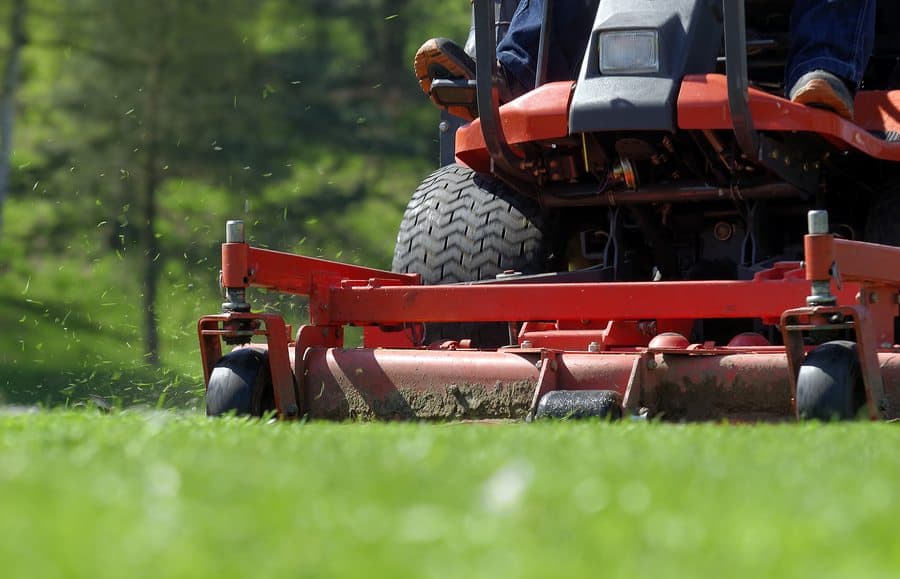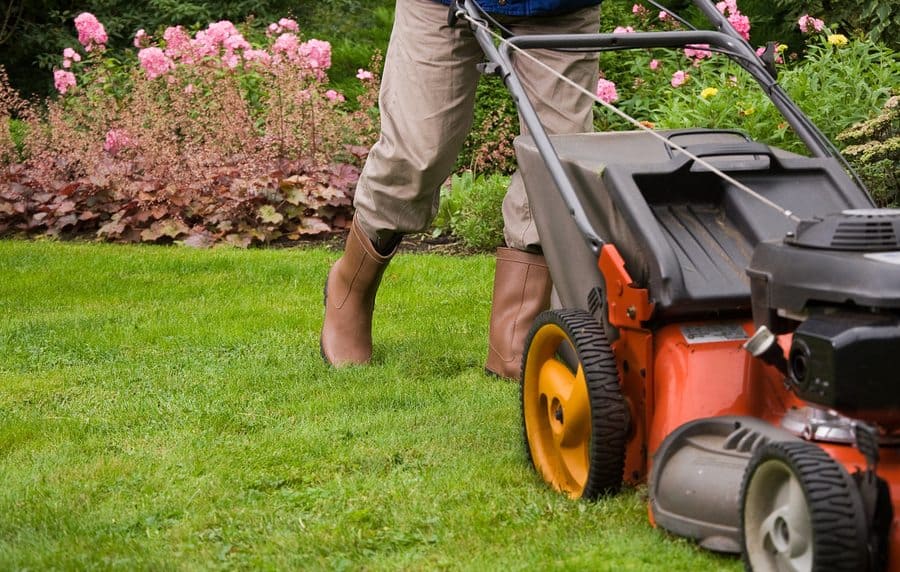Precise green stripes, a rolling carpet of soft grass, and the smell of freshly cut clippings. A well-maintained lawn is an American fixture, and from coast to coast and border to border, you can find neatly manicured yards stretching across suburbia. The perfect lawn couldn’t be the phenomenon that it is without constant mowing. But are mowers a useful tool, or a necessary evil? Lawnmowers cause numerous accidents every year, and with summer kicking into gear, the season for lawnmower injuries is upon us. In this entry of our Strange But True blog series, we’ll be taking a look at personal injury cases from lawnmower accidents.
It’s strange that most people consider mowing the lawn to be a perfectly safe and routine summer chore. In some sense, perhaps it the commonality of the task that makes it seem safe. That is, each year millions of Americans mow their lawns millions of times and no incidents occur. However, mowing the lawn is one of the most dangerous household tasks one can do. The mower’s spinning blades can cut you, the other moving parts that my crush body parts or pull loose clothing into the machine, and the weight of the machine can crush a careless operator. All in all, according to statistics compiled by the Consumer Products Safety Commission (CPSC) in 2009, nearly 20,000 people were killed by lawnmowers and nearly 300,000 suffered an injury of some type. 2011 data shows that more than 17,000 children or teens required medical attention in that year due to lawnmower injuries. Our Philadelphia wrongful death lawyers explain further below:

Mower Safety Features and Precautions Fail to Prevent Injuries
Safety features in lawn mowers are intended to prevent injuries from occurring. While advances in both technology and precautions have taken place, they have not been sufficient. Compared to airbags and the automated collision avoidance systems of some car and trucks, a lawn mower’s safety systems are still rather crude including features such as a:
- Dead-man’s switch – Present in both ride-on and push mowers, this switch is designed to stop the mower and disengage the cutting blade if human control is lost. In a push mower, the switch is typically located on the hand bar and must be depressed to prevent a kill switch from stopping the engine. In a ride-on mower, the switch is often installed in the mower’s seat causing the mower engine to disengage if the driver falls from the driver’s seat
- Safety shield – Typically installed near the discharge chute, these shields are intended to prevent debris from being ejected into the air by the mower
- Warning label – All modern lawn mowers carry at least one, and typically more, warning labels. These warning labels make consumers aware of particularly dangerous locations on the machine where moving parts can catch clothing or where spinning blades may inadvertently cause an amputation.
But as the above statistics make abundantly clear: these measures are ineffective in hundreds of thousands of instances each year where catastrophic injury is sustained or death occurs. The main reasons for lawn mower injuries include roll-overs leading to traumatic brain injuries and crushing, lacerations or accidental amputations due to moving parts or blades, and burn injuries due to overheating or engine fire.
253,000 Lawnmower Injuries in 2010 Alone
When we talk about kitchen safety, there’s one appliance we pay special attention: the blender. That’s because blenders feature razor-sharp blades that spin at extremely high speeds, and the potential for terrible injury is obvious. Fortunately, blenders are small and stationary, and a simple lid is sufficient to prevent accidents.
Now imagine that your blender is enormous, and you’re muscling it across a lumpy, uneven swath of thick grass that could be concealing anything.
What you’re left with is a lawnmower.
Of course, that’s a simplification; but a lawnmower is a huge, heavy, powerful set of rapidly-moving blades. It’s all too easy to be seriously hurt — or killed.
How easy may surprise you. According to the U.S. Consumer Products Safety Commission, on an annual basis, roughly:
- 800 children will be hit or run over.
- 75 people will be killed.
The Commission also reported 253,000 lawnmower injuries in 2010 alone. Among them, 17,000 affected people under 19 years old.
According to the Amputee Coalition of America, a yearly average of 600 children will have to have an amputation as a result of a lawnmower accident. In fact, the Coalition reports that lawnmowers are the number one cause of major amputations for children under ten years old.
If none of those statistics are frightening enough, consider this sobering statement from the American Academy of Orthopedic Surgeons: “The energy transferred by a typical lawn mower blade is equivalent to being shot in the hand with a .357 magnum pistol.”

Zero Turn Radius (ZTR) Mower Rollover Accidents
You would think where such a dangerous product is concerned, every possible safety precaution would be taken by designers and manufacturers. Unfortunately, you would be mistaken. Certain types of lawnmowers and mower features have been repeatedly identified as serious safety hazards, yet continue to be readily available in the consumer market.
Zero Turn Radius (ZTR) mowers are prized for their precision maneuverability. Unfortunately, the same technology that enables such tight, responsive turning is also to blame for a high risk of rollover.
It doesn’t take much to knock a ZTR mower off of its “feet.” Even tiny inconsistencies like small holes or shallow grades, which common in any lawn, can interfere with ZTR mower stability. Furthermore, many ZTR mowers are equipped with drum brakes which are located on the rear axle, when disc brakes on the front would provide far better sudden braking ability.
Manufacturers are aware that ZTR mowers can be tricky to handle and have a tendency to roll easily. For this reason, some of them have outfitted their products with Rollover Protection Systems — but not all. The technologies exist, and the mower manufacturers are aware of the risks to consumers, yet ROPS is not always in place.
Death By Flying Lawn Mower
We have saved the most spectacular incident of lawn mower use gone wrong for last. Although many people probably wouldn’t believe it, in 1979, 2 fans were catastrophically injured by a flying lawnmower during the half-time show of a Jets-Patriots NFL game.
The halftime show consisted of a display put on by the Electronic Eagles of the Radio Control Association of New York. The participants would fly uniquely designed radio-controlled airplanes in a model airshow. Daring maneuvers by the model airplanes were indeed to enthrall the crowds, but the close proximity of the planes to the audience combined with one of the planes crashing into the football field had put the crowd on edge. Unfortunately, this crash merely foreshadowed the horror that was to come.
At the end of the halftime show, another plane, this one shaped like a push lawnmower, went out of control. It looped around in the air several times before nose-diving into the crowd. On its descent, the lawnmower-shaped plane struck two patrons causing traumatic brain injuries to both. The 25-year-old man suffered a concussion and was admitted to the hospital, however, he was the luckier of the two individuals. The 20-year-old man suffered severe cranial injuries including severe lacerations. One witness remarked that it looked, “like he had been attacked by an ax.” He would pass away 4 days after his catastrophic injury.
Major Lawnmower Recalls
Considering the sky-high numbers of lawnmower injuries that happen every year, it comes as little surprise that lawnmower accidents and defects have led to numerous recalls and lawsuits.
In January of 2014, Honda recalled over 20,000 units in the United States. The models affected by the recall included the HRR2169VLA and the HRX2174VLA. It was determined that blades in the mower would continue to rotate even after the control lever was released.
The Toro Company recalled almost 4,000 units of its Toro Z Master Commercial 2000 Series after receiving half a dozen reports of friction between a pulley and the fuel tank. This design oversight could have created a potentially explosive fire hazard for innocent riders.
The Toro Company has had other run-ins with recalls as well. In December of 2013, nearly 35,000 units in the U.S. were included in a recall of TimeMaster and TurfMaster mowers when it was determined that the mower’s blades could easily break. Ten reports of broken blades were received.
Manufactured by Excel Industries, approximately 3,700 Hustler and Big Dog riding mowers were recalled after it was discovered that these models could continue to operate even after the rider dismounted the vehicle.
In the case of Purdy v. Deere, which was filed as recently as April of 2014, the plaintiff alleged that a safety feature had failed. Dwight Purdy stated he had accidentally backed over his daughter, causing severe injury, after accidentally overriding a critical “no mow in reverse” safety feature. Purdy asserted that the product was negligently designed.
While the judge ruled in favor of the defendant following an initial trial and appeal, the Oregon Supreme Court is now reconsidering Purdy’s case.
If you or someone you love has been injured by a defective or negligently designed lawnmower or riding mower, you may have a strong case for a defective product claim. To schedule a free consultation with an experienced personal injury attorney, call the law offices of The Reiff Law Firm at (215) 709-6940, or contact us online today.
Related Posts
- Pennsylvania Full Tort Auto Insurance Explained
- What to Do if You Were Injured Taking Darvon or Darvocet
- How Much Does Car Insurance Go Up After an Accident in Pennsylvania?
- How Do Bike Lanes Affect Personal Injury Cases in Philadelphia?
- Should I Sue the Doctor or the Hospital for Medical Malpractice?















